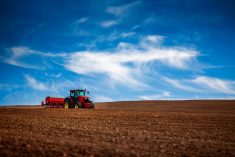Go hard. Then go even harder. Expand fast, then expand some more. This is the moment that farmers have been waiting for. There are so many more mouths to fill, so many more consumers who want more meat on their plates, and so many more gas tanks that only farmers can fill.
Or, go slow. Go very slow. Look twice at every move before you make it. Look at it top, down and sideways because interest rates are set to explode, commodity prices are more volatile than ever, and the world’s politicians are just itching to set up massive trade barriers.
Read Also

Farmland values: assumptions and realities
Where farmland values are headed and what decisions farmers should make
Go fast, go slow. Rarely has there been so much advice that’s so persuausive and yet so utterly in conflict.
What’s a farm to do? Business schools teach a clear set of rules for such quandaries. First, they tell you to ask yourself, how strong is the long-term outlook for the sector? Then ask, how is your performance compared to the industry average, because having a cost of production that is lower and an output that is higher and more consistent than the average acts like magic for reducing risks and increasing management flexibility.
Last, take a hard look at your cash flow and your overall financial resources. The results will tell you whether to expand, bail out or diversify.
It’s sound advice. In agriculture, though, it isn’t sound enough, and not just because the shake-outs that other industries are experiencing read like ancient history on the farm.
As we started work on this issue of Country Guide, we thought the challenge would be to think clearly about the future in an industry that doesn’t know what price it will get for its crops and livestock in six months. It turns out that this wasn’t the challenge at all. Like the businesses in the article “Big Plans,” it’s clear we already know much of what it will take to be competitive in 2019.
Instead, the lesson at every turn was that the future belongs to what we might call self-directed innovators. It belongs to managers who know that finding a more efficient way to manage your crops will always be helpful and maybe even essential. But the innovation that truly pays will be business innovation. GM may build the most innovative SUVs in the world, and Sony could be the best engineering company on the planet for producing Walkmans, but because they didn’t have innovative business processes that identified and attacked new business opportunities, their product innovation only helped lead them downward.
So the choice isn’t really between expanding or divesting. It’s between being strategic or being left on the sidelines. In an important way, investments don’t matter as much as strategies, because investment plans rise out of strategies, not the other way around.
Which is a good thing, because I’ve never encountered a more strategically minded group than today’s upcoming generation of farmers.
Are we getting it right? Let us know. Call me at 519 674-1449, or e-mail me at [email protected].We want to hear from you.















